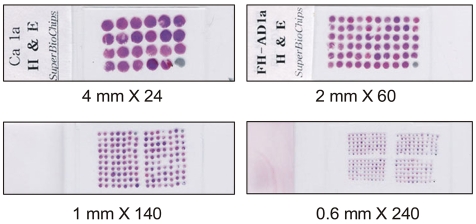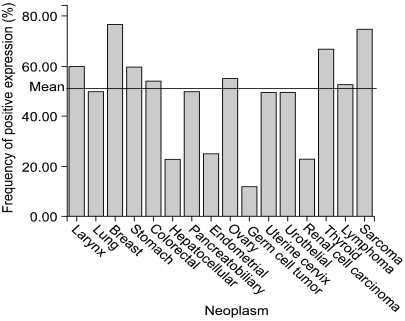Cancer Res Treat.
2006 Feb;38(1):1-6.
Tissue Array Methods for High-throughput Clinicopathologic Research
- Affiliations
-
- 1Department of Pathology, Seoul National University Bundang Hospital, Seongnam, Korea.
- 2Department of Pathology, Seoul National University College of Medicine, Seoul, Korea. woohokim@snu.ac.kr
Abstract
- Recent research in molecular biology has identified a significant number of novel markers, which may have diagnostic, prognostic and therapeutic significance. High-throughput tissue array method facilitates the validation of novel markers by enabling the simultaneous analysis of hundreds or thousands of tissue specimens. Tissue array slides can be analyzed using techniques such as immunohistochemistry and in situ hybridization. In this review, we give a brief overview of tissue array method and its application to high throughput clinicopathologic research.
Figure
Reference
-
1. Waterston RH, Lindblad-Toh K, Birney E, Rogers J, Abril JF, Agarwal P, et al. Initial sequencing and comparative analysis of the mouse genome. Nature. 2002; 420:520–562. PMID: 12466850.
Article2. Venter JC, Adams MD, Myers EW, Li PW, Mural RJ, Sutton GG, et al. The sequence of the human genome. Science. 2001; 291:1304–1351. PMID: 11181995.
Article3. Schena M, Shalon D, Davis RW, Brown PO. Quantitative monitoring of gene expression patterns with a complementary DNA microarray. Science. 1995; 270:467–470. PMID: 7569999.
Article4. Templin MF, Stoll D, Schrenk M, Traub PC, Vohringer CF, Joos TO. Protein microarray technology. Trends Biotechnol. 2002; 20:160–166. PMID: 11906748.
Article5. Battifora H. The multitumor (sausage) tissue block: novel method for immunohistochemical antibody testing. Lab Invest. 1986; 55:244–248. PMID: 3525985.6. Battifora H, Mehta P. The checkerboard tissue block. An improved multitissue control block. Lab Invest. 1990; 63:722–724. PMID: 2232717.7. Kononen J, Bubendorf L, Kallioniemi A, Barlund M, Schraml P, Leighton S, et al. Tissue microarrays for high-throughput molecular profiling of tumor specimens. Nat Med. 1998; 4:844–847. PMID: 9662379.
Article8. Fedor HL, De Marzo AM. Practical methods for tissue microarray construction. Methods Mol Med. 2005; 103:89–101. PMID: 15542899.
Article9. Mousses S, Kallioniemi A, Kauraniemi P, Elkahloun A, Kallioniemi OP. Clinical and functional target validation using tissue and cell microarrays. Curr Opin Chem Biol. 2002; 6:97–101. PMID: 11827831.
Article10. Schraml P, Kononen J, Bubendorf L, Moch H, Bissig H, Nocito A, et al. Tissue microarrays for gene amplification surveys in many different tumor types. Clin Cancer Res. 1999; 5:1966–1975. PMID: 10473073.11. Bubendorf L, Nocito A, Moch H, Sauter G. Tissue microarray (TMA) technology: miniaturized pathology archives for high-throughput in situ studies. J Pathol. 2001; 195:72–79. PMID: 11568893.12. Lee HS, Lee HK, Kim HS, Yang HK, Kim YI, Kim WH. MUC1, MUC2, MUC5AC, and MUC6 expressions in gastric carcinomas: their roles as prognostic indicators. Cancer. 2001; 92:1427–1434. PMID: 11745219.13. Camp RL, Charette LA, Rimm DL. Validation of tissue microarray technology in breast carcinoma. Lab Invest. 2000; 80:1943–1949. PMID: 11140706.
Article14. Hoos A, Urist MJ, Stojadinovic A, Mastorides S, Dudas ME, Leung DH, et al. Validation of tissue microarrays for immunohistochemical profiling of cancer specimens using the example of human fibroblastic tumors. Am J Pathol. 2001; 158:1245–1251. PMID: 11290542.
Article15. Kim WH. Tissue array method for large scale clinicopathologic study. Korean J Pathol. 2002; 36:199–204.16. Shergill IS, Shergill NK, Arya M, Patel HR. Tissue microarrays: a current medical research tool. Curr Med Res Opin. 2004; 20:707–712. PMID: 15140337.
Article17. Darwish NS, Kim MA, Chang MS, Lee HS, Lee BL, Kim YI, et al. Prognostic significance of CD24 expression in gastric carcinoma. Cancer Res Treat. 2004; 36:298–302.
Article18. Bae SI, Lee HS, Kim SH, Kim WH. Inactivation of O6-methylguanine-DNA methyltransferase by promoter CpG island hypermethylation in gastric cancer. Br J Cancer. 2002; 86:1888–1892. PMID: 12085181.19. Kim YH, Lee HS, Lee HJ, Hur K, Kim WH, Bang YJ, et al. Prognostic significance of the expression of Smad4 and Smad7 in human gastric carcinomas. Ann Oncol. 2004; 15:574–580. PMID: 15033661.
Article20. Lee HS, Yang HK, Kim WH, Choe G. Loss of DNA-dependent protein kinase catalytic subunit (DNA-PKcs) expression in gastric cancers. Cancer Res Treat. 2005; 37:98–102.
Article21. Kang YH, Lee HS, Kim WH. Promoter methylation and silencing of PTEN in gastric carcinoma. Lab Invest. 2002; 82:285–291. PMID: 11896207.
Article22. Woo DK, Kim HS, Lee HS, Kang YH, Yang HK, Kim WH. Altered expression and mutation of beta-catenin gene in gastric carcinomas and cell lines. Int J Cancer. 2001; 95:108–113. PMID: 11241321.23. Lee HS, Chang MS, Yang HK, Lee BL, Kim WH. Epstein-Barr virus-positive gastric carcinoma has a distinct protein expression profile in comparison with Epstein-Barr virus-negative carcinoma. Clin Cancer Res. 2004; 10:1698–1705. PMID: 15014022.
Article24. Lee HS, Lee HK, Kim HS, Yang HK, Kim WH. Tumor suppressor gene expression correlates with gastric cancer prognosis. J Pathol. 2003; 200:39–46. PMID: 12692839.25. Jacquemier J, Ginestier C, Rougemont J, Bardou VJ, Charafe-Jauffret E, Geneix J, et al. Protein expression profiling identifies subclasses of breast cancer and predicts prognosis. Cancer Res. 2005; 65:767–779. PMID: 15705873.26. Andersen CL, Monni O, Wagner U, Kononen J, Barlund M, Bucher C, et al. High-throughput copy number analysis of 17q23 in 3520 tissue specimens by fluorescence in situ hybridization to tissue microarrays. Am J Pathol. 2002; 161:73–79. PMID: 12107091.
Article27. Lee HS, Kim WH, Kang GH. Hepatocyte expressions in hepatocellular carcinomas, gastrointestinal neoplasms, and non-neoplastic gastrointestinal mucosa: its role as a diagnostic marker. J Korean Med Sci. 2003; 18:842–848. PMID: 14676441.
Article28. Fejzo MS, Slamon DJ. Frozen tumor tissue microarray technology for analysis of tumor RNA, DNA, and proteins. Am J Pathol. 2001; 159:1645–1650. PMID: 11696425.
- Full Text Links
- Actions
-
Cited
- CITED
-
- Close
- Share
- Similar articles
-
- Tissue Array Method for Large Scale Clinicopathologic Study
- Tissue-Engineered 3D In Vitro Disease Models for HighThroughput Drug Screening
- Next generation sequencing and array-based comparative genomic hybridization for molecular diagnosis of pediatric endocrine disorders
- Genomic DNA Aberration Profiles in Paraffin-Embedded Breast Tumor Using Array-CGH on c-erbB-2 Overexpression
- Development of Multi-tissue Array Block for Diagnosis of Early Myocardial Infarction




